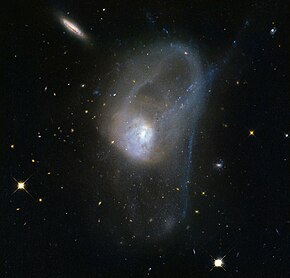

| NGC 3921 | |
|---|---|

NGC 3921, imaged by the Hubble Space Telescope
| |
| Observation data (J2000 epoch) | |
| Constellation | Ursa Major |
| Right ascension | 11h51m 06.863s[1] |
| Declination | +55° 04′ 43.38″[1] |
| Redshift | 0.019667[2] |
| Heliocentric radial velocity | 5896 km/s[2] |
| Distance | 277.9 Mly (85.19 Mpc)[3] |
| Apparent magnitude (V) | 12.64[4] |
| Apparent magnitude (B) | 13.4[4] |
| Absolute magnitude (V) | −22.09[5] |
| Characteristics | |
| Type | (R')SA0/a(s) pec[2] |
| Size | 180,200 ly (55,240 pc)[2][note 1] |
| Apparent size (V) | 2.1′ × 1.3′ |
| Other designations | |
| Arp 224, UGC 6823, MGC+09-20-009, PGC 37063 | |
NGC 3921 is an interacting galaxy in the northern constellationofUrsa Major. Estimates using redshift put it at about 59 million light years (18megaparsecs) from Earth.[3] It was discovered on 14 April 1789 by William Herschel,[6] and was described as "pretty faint, small, round" by John Louis Emil Dreyer, the compiler of the New General Catalogue.[7]
NGC 3921 is the remnant of a galaxy merger. The two progenitor galaxies are thought to have been disk galaxies that collided about 700 million years ago.[8] The image shows noticeable star formation and structures like loops, indicative of galaxies interacting.[8] Because of this, NGC 3921 was included in Halton Arp's Atlas of Peculiar Galaxies under the designation Arp 224.[4]
Being a starburst galaxy, NGC 3921 has important features. One of them is an ultraluminous X-ray source, designated X-2, with an X-ray luminosity of 8×1039 erg/s.[9] Additionally, two candidate globular clusters have been detected within NGC 3921.[5] They are both fairly young, and about half as massive as Omega Centauri, demonstrating that mergers of gas-rich galaxies can also create more metal-rich globular clusters.[5]